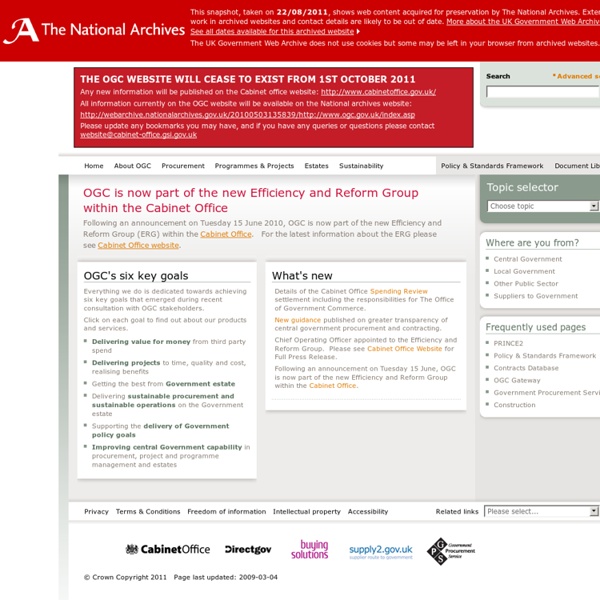



Innovation across central government "Despite the large sums of money being invested in encouraging innovation, central government isn’t making the most of the opportunities to improve the delivery of public services. Innovation within service delivery is vital and government must be sure that it encourages staff to contribute, listens to the people who use its services and measures what it is getting for the investment made." Tim Burr, head of the National Audit Office, 26 March 2009 Government faces increasing pressure to do more with fewer financial resources and, with challenges such as climate change and an ageing population, will require innovation in public services. The majority of cases of innovation seen by the NAO originated with senior management within departments. Although clear guidance and signals from leaders and senior management within departments would help remove some of these barriers, it is important that departments develop strategies for encouraging and developing innovation. Publication details:
La Méthode des QQOQCP – méthodes et outils de gestion – Introduction: Toute entreprise est confrontée à des problèmes aussi variés, Certains ont des solutions évidentes. D’autres sont plus complexes, et nécessitent une grande compréhension de la situation. La méthode QQOQCP permet d'avoir sur toutes les dimensions du problème, des informations élémentaires suffisantes pour identifier ses aspects essentiels. Elle adopte une démarche d'analyse critique constructive basée sur le questionnement systématique. Synonymes : QQOQCP : Quoi? Principe : Il s’'agit de poser les questions de façon systématique afin de n'’oublier aucune information connue : - 1 - Quoi? De Quoi s'agit-il ? - 2 - Qui? Qui est concerné ? - 3 - Où? Où cela se produit-il et s'applique-t-il ? - 4 - Quand? Depuis quand vous avez ce problème? - 5 - Comment? Comment se produit le problème? - 6 - Pourquoi?
Data.gov Remember the 5 W's | IT Best Practices | University of Nebraska–Lincoln No matter the size of your project when you are determining the requirements for a new or enhanced solution, it always pays to remember the 5 W's: Who deals with identifying the various actors and players in a solution. These are examples of the kinds of questions you should be asking with respect to the "Who" of the intended solution: Who needs to use or interact with the solution? Who derives value from the solution? What deals with identifying the various functionalities, data, inputs, outputs, deliverables, artifacts, etc. of the intended solution. These are examples of the kinds of questions you should be asking with respect to the "What" of the intended solution: What are the goals and objectives of the solution (should be stated in business terms)? When deals with various time-based events, activities, etc. of the intended solution. These are examples of the kinds of questions you should be asking with respect to the "When" of the intended solution: Where are the users located?
The need for KPIs versus FOIs | Talkin' bout a revolution Earlier today, the Office of Government Commerce (OGC) published the “traffic light” statuses and gateway reviews of 23 high-risk IT-related projects. This information was requested by Computer Weekly three years ago, but has only now been made public. The disclosures were made as a result of Computer Weekly’s application under the FOI Act in April 2006 for: The results of all Gateway reviews on high-risk IT-related projects carried out over the past year at the Home Office, Department of Health, including Connecting for Health. and the Department for Work and Pensions, including CSA. The Information Commissioner ruled that it was in the public interest for this FOI request to be met in full – except for one high-risk IT-related project, which was so secret it could not even be named. While this openness is welcome, it should be noted that the OGC has decided not to release the entire reports, and the information it has released is at least three years old. IT Dashboard An Open KPI Future?
Réseau Qualité en Recherche - QQOQCP : Quoi, Qui, Où, Quand, Comment, Pourquoi ? Quoi, Qui, Où, Quand, Comment, Pourquoi La méthode QQOQCP est un aide-mémoire pour cette préparation. Il sert à identifier le problème dans son ensemble à partir de 6 questions : Qui ? Qui est concerné : responsables, acteurs, * Quels sont les personnes, services et sites concernés par la situation ? Quoi ? De Quoi s’agit-il : objet, méthodes, opérations, ... * Quels sont les éléments, actions, opérations qui caractérisent la situation ? Où Où le problème apparaît-il : service, atelier, process, ... * Où se passe la situation, à quel endroit ? Quand Date, durée, fréquence, planning, ... * Quand se passe la situation : date, mois, jour, poste, ... ? Comment ? Moyens, matériels, procédure, manière, ... * Comment se déroule la situation ? Pourquoi ? A chaque question, se demander pourquoi ? * Pourquoi réaliser telle action ? Conclusion La question Combien ? * Combien et quelle unité ? * Bien préciser dès le départ l’objet de l’analyse : problème ou solution ?